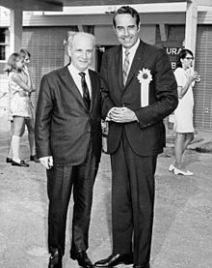Hampar Kelikian
Wednesday, June 26, 2019
A pioneer in the restoration of damaged limbs, he was instrumental in helping U.S. Senator Bob Dole. When Dole returned from World War II with injuries that had left his right arm frozen and about to be amputated, Kelikian fixed the shattered shoulder and allowed Dole to regain some use of his arm.
During World War II, Kelikian served as chief orthopedic surgeon and lieutenant colonel at the 297th General Hospital. Bob Dole was one of his many patients, and Kelikian refused to accept any fees from the young veteran, since his brother Siragan had been killed in Italy in 1943. In total, Kelikian performed seven operations between 1947 and 1953 to restore the use of Dole's arm by transplanting leg bone and muscle to the right shoulder and hand. He saved the left arm of a young Victor A. Lundy, who would become a leading architect of the Sarasota Modern; Kelikian never discharged his patient, who would serve as his medical artist. Upon his return to Chicago, he joined the staff of Wesley Hospital and Northwestern Medical School.
Kelikian later became an emeritus associate professor of orthopedic surgery, performing ten operations a week when he was 80. Kelikian wrote three classic monographs on hand, ankle, and foot surgery, as well as a book on Armenian poetry. He also specialized in congenital deformities, particularly gigantism and on phocomelia due to thalidomide. He never charged Armenians for treatment.
Kelikian had a son Armen, also a surgeon, and two daughters, Alice and Virginia, by his wife Ovsanna (née Kupelian). He died on Sunday July 24, 1983 at Northwestern Memorial Hospital in Chicago. He was 84.
Achievements
While he was working for the United States Army, his services were recognized by President Harry Truman, who gave him a citation and a medal. He also received a citation from the Queen while working as a consulting orthopaedic surgeon at the Ronkswood General Hospital in Worcester.[citation needed] In 1969, he was appointed to President Nixon’s Task Force for the Disabled. In 1966 he was invited to visit Lebanon by Professor Emile Riachi, his former resident, and was awarded the Order of the National Cedars of Lebanon by President Charles Helou





